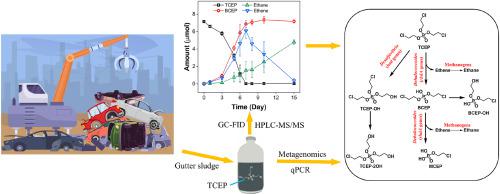Environmental Pollution ( IF 7.6 ) Pub Date : 2023-10-06 , DOI: 10.1016/j.envpol.2023.122704 Sen Yang 1 , Junhong Wu 1 , Heli Wang 1 , Qian Yang 1 , Huanheng Zhang 2 , Lihua Yang 3 , Dan Li 4 , Yirong Deng 5 , Yin Zhong 6 , Ping'an Peng 6

|
End-of-life vehicles (ELVs) dismantling sites are the notorious hotspots of chlorinated organophosphate esters (Cl-OPEs). However, the microbial-mediated dechlorination of Cl-OPEs at such sites has not yet been explored. Herein, the dechlorination products, pathways and mechanisms of tris(2-chloroethyl) phosphate (TCEP, a representative Cl-OPE) by an anaerobic enrichment culture (ZNE) from an ELVs dismantling plant were investigated. Our results showed that dechlorination of TCEP can be triggered by reductive transformation to form bis(2-chloroethyl) phosphate (BCEP), mono-chloroethyl phosphate (MCEP) and by hydrolytic dechlorination to form bis(2-chloroethyl) 2-hydroxyethyl phosphate (TCEP-OH), 2-chloroethyl bis(2-hydroxyethyl) phosphate (TCEP-2OH), 2-chloroethyl (2-hydroxyethyl) hydrogen phosphate (BCEP-OH). The combination of 16S rRNA gene amplicon sequencing, quantitative real-time PCR (qPCR) and metagenomics revealed that the Dehalococcoides played an important role in the reductive transformation of TCEP to BCEP and MCEP. A high-quality metagenome-assembled genome (completeness >99% and contamination <1%) of Dehalococcoides was obtained. The sulfate-reducing bacteria harboring haloacid dehalogenase genes (had) may be responsible for the hydrolytic dechlorination of TCEP. These findings provide insights into microbial-mediated anaerobic transformation products and mechanisms of TCEP at ELVs dismantling sites, having implications for the environmental fate and risk assessment of Cl-OPEs at those sites.
中文翻译:

汽车拆解场厌氧富集磷酸三(2-氯乙基)酯脱氯新产物及机理
报废车辆 (ELV) 拆解场是臭名昭著的氯化有机磷酸酯 (Cl-OPE) 热点地区。然而,微生物介导的 Cl-OPE 在这些位点的脱氯尚未得到探索。在此,研究了来自报废汽车拆解厂的厌氧富集培养物(ZNE)对磷酸三(2-氯乙基)酯(TCEP,一种代表性的 Cl-OPE)的脱氯产物、途径和机制。我们的结果表明,TCEP 的脱氯可以通过还原转化形成磷酸二(2-氯乙基)酯(BCEP)、磷酸一氯乙酯(MCEP)以及通过水解脱氯形成磷酸二(2-氯乙基)2-羟乙酯( TCEP-OH)、2-氯乙基双(2-羟乙基)磷酸盐(TCEP-2OH)、2-氯乙基(2-羟乙基)磷酸氢盐(BCEP-OH)。16S rRNA基因扩增子测序、实时定量PCR(qPCR)和宏基因组学相结合揭示了Dehalococcoides在TCEP向BCEP和MCEP的还原转化中发挥了重要作用。获得了高质量的Dehalococcoides宏基因组组装基因组(完整性 >99%,污染 <1%) 。含有卤酸脱卤酶基因( had )的硫酸盐还原菌可能负责TCEP的水解脱氯。这些发现提供了对报废车辆拆解地点微生物介导的厌氧转化产物和 TCEP 机制的深入了解,对这些地点 Cl-OPE 的环境命运和风险评估具有影响。






























 京公网安备 11010802027423号
京公网安备 11010802027423号